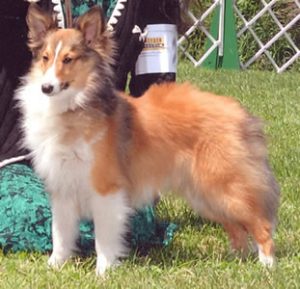
The Shetland Sheepdog, often known as the Sheltie and sometimes as the Shetland Collie, is a breed of dog in the herding dog group.
Shelties have the herding dog temperament. They are vocal, excitable, energetic dogs who are always willing to please and hard workers. They were used in the Shetland Islands for herding and protecting sheep.
They are small dogs, 13-16 inches at the withers by AKC Conformation standards, and they come in a variety of colours, such as Sable/White, Tri-colour, Blue Merle, and so forth.
Their early history is not well-known. They originally were a small mixed breed dog, often 8-10 inches in height. It is thought that they were a cross of a Spitz type dog from Scandinavia with the local sheepdog. In the early 1900’s, James Loggie added a small show Collie to the stock, and the modern Shetland Sheepdog was born. The original name of the breed was Shetland Collie, but this caused controversy among Collie breeders, and the breed’s official name was changed to Shetland Sheepdog.
The breed was recognised by the English Kennel Club in 1909.
Coat and Colours
Shelties have a double coat, which means that they have two layers of fur that make up their coat. The long, rough guard hairs lie on top of the thick, soft undercoat. The guard hairs are water-repellent, while the undercoat provides relief from both high and low temperatures. There are three main colourations: sable, which ranges from golden to mahogany; tri-colour, made up of black, white and tan; and blue merle, made up of grey over other colours.
Bi-Black (white and black) and bi-blue (white, black and grey) are less common but still acceptable. The best-known colour is the sable, which is dominant over other colours. Shaded, or mahogany, sables can sometimes be mistaken for tri-coloured Shelties due to the large amount of dark shading on their coats. Another name for a shaded sable is a tri-factored sable and white. This name comes from the breeding of a tri-colour to a sable and white, or a tri-factored sable to another tri-factored sable. Another acceptable colour in the show ring, but much less seen, is the sable merle, which can often be hard to distinguish from regular sables after puppyhood. The sable merle would have patches of dark brown on a light brown background, as compared to the black and grey of a blue merle.
There are two additional coat colours that are quite rare because they are unacceptable in the breed ring. The colour-headed white (majority of fur white, with the head ‘normally’ marked) can occur when two white-factored dogs are mated. Double merles, a product of breeding two merle Shelties together, can be bred but have a higher incidence of deafness or blindness than the other coat colours. There have been reports of a brindle Sheltie but many Sheltie enthusiasts agree that a cross sometime in the ancestry of that specific Sheltie could have produced a brindle. Unacceptable colours in the show ring are a rustiness in a blue or black coat. Colours may not be faded, no conspicuous white spots, and the colour cannot be over 50% white.
Height and Weight
The AKC breed standard for height is from 13 to 16 inches (33 to 41 cm). A measurement outside this range will result in dismissal from the conformation ring, and three dismissals result in the dog being banned from any more conformation classes.
Shelties normally weigh around 11–25 pounds (5.0–11 kg).
Temperament
The Shetland Sheepdog is an outstanding companion dog and is intensely loyal. It is lively, intelligent, trainable, and willing to please and obey. Shelties are loving, loyal, and affectionate with their family, but are naturally aloof with strangers; for this reason Shelties must be socialised. The Shetland Sheepdog Standard from the AKC allows them to be reserved to strangers, but they should not show fear. Shelties do well with children if they are reared with them from an early age; however, their small size makes it easy for a child to accidentally injure them, so supervision is necessary. Exercise caution when considering an adult Sheltie for a family with young children; they may not be compatible.
Shelties are vocal dogs. They are intensely loyal, affectionate and responsive to their owner; reserved but not shy or fearful. Some shelties display a terrier-like personality, which tends to be hyper, and always on the go; however, this temperament is not sanctioned in the breed standard. Some Shelties can be very timid but this temperament is specifically discouraged by the breed standard. Tendencies towards shyness can be reduced through proper socialisation. The average Sheltie is an excellent watch dog, giving alarm barks when a person is at the door, or a car is in the driveway.
—————————————————————————————————————–
CARING FOR YOUR DOG NEWSLETTER – Delivered Directly To Your Inbox – Starting Immediately – SIGN UP FOR FREE TODAY
—————————————————————————————————————–
